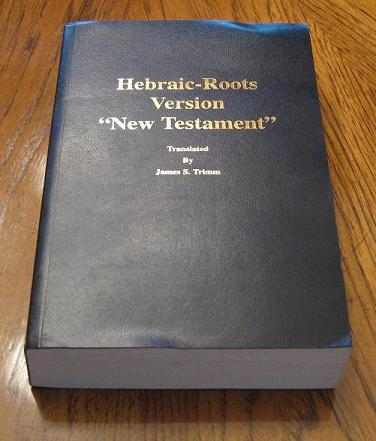

Rating
Price and Value
Scroll down to the bottom for pictures!
Summary of Features
Feature
Publication Date
2001
Cover
Soft Cover
Size
8.07 inches tall
5.1 inches long
1.3 inches thick
Binding
Glued
Thumb-Index Tabs
No
Text Format
Single Column Verse Format
Headings
None
Mashiyach's Words in Red
No
Number of Ribbon Markers
Zero
Gold Gilded w/ Rounded Corners
No
Extensive Cross References
No
Helps
Extensive Introduction
Footnotes
Basic Cross References
Basic Manuscript Comments
Concordance
No
Maps
None
Name of the Father
YHWH
Name of the Son
Yeshua
Hebrew Transliterations
Names and places
Book Order
Eastern Aramaic Order
Good News
Acts
General Epistles
Pauline Epistles
Revelation
Base Text
The Way International's Aramaic/English Interlinear
Old Archaic English
No
Manuscript Origin
Dutillet, Munster and Shem Tob Matthew (primary/consulted)
Peshitta New Testament (primary)
Old Syriac Gospels (primary consultant)
Codex Khabouris (consulted)
Review
The Hebraic-Roots Version New Testament was a highly anticipated translation of the Ketuvim Netzarim since it was the first Messianic Sacred Name Translation (which at the time of publication were non-existent other than ISR's "The Scriptures") to be translated directly from Semitic source texts (Hebrew and Aramaic). It is also the first Sacred Name Bible to include the correct insertion of YHWH into the Netzarim writings based on manuscript evidence, not theological assumptions. This in and of itself makes it a very valuable translation. However, despite these valuable attributes, one is left desiring a little more from the HRVNT.
Let me get the drawbacks out of the way first. The Hebraic-Roots Version "New Testament" is horrible bound! You can see the pictures below to get an idea, but it's a glued paper back version that's so stiff that you have to pry it open with your hands while reading. This puts substantial creases in the spine of the book, but it's unavoidable if you want to read the text. This is a big draw back since it ruins the reading experience in a lot of ways. This is the Word of Elohim we're dealing with, and it should show in how we treat it with binding and printing. The second drawback is a matter of textual integrity. Upon close examination it seems that the majority of the text is a copy of The Way International's Aramaic-English Interlinear. No where is credit given for using this copyrighted translation as a base text and in fact, Trimm boasts that this is a fresh translation (and continues to do so despite people providing evidence). I would be very weary of supporting a ministry that may be unlawfully conducting business. However, I will say that The Way's Interlinear is a decent translation, so you are getting a good Peshitta translation that's simply been tampered with in favor of modern day Netzarim theology (using the Divine names and Hebraic terminology, etc.). Not all of the text comes from the Peshitta though. Trimm sometimes takes renderings from the "Old Syriac Gospels" (which are not as accurate as the Peshitta) and the Good News according to Matthew is taken primarily from the Hebrew Matthew texts out there. In fact, it's a revision of Trimm's own translation of the Munster Hebrew text (which was also a revision of a previous translation). This is a major draw back because, having read the Hebrew Texts myself, I can tell you with honest conviction that they are not in any way the inspired version of Matthew. Although an Aramaic Primacist, I would take the Greek over the Hebrew texts any day of the week. There is extremely weak manuscript evidence for the Hebrew, they are 1000 years removed from the earliest Greek and Aramaic texts, and they disagree with one another profoundly. The idea of Hebrew originals is a cool thought, but where are the manuscripts? Aramaic in Hebrew letters is the likely form of the original Matthew prior to the Peshitta/Khabouris Codex.
Despite my arguments against Matthew though, there are some positive points. In letters from the church founders, we have quotes from the "Gospel according to Hebrews which is used by the Nazarenes", which some say was the original Matthew. The manuscript itself is lost, but through these quotes we have fragments from what it said. Trimm footnotes all of them in the places which they would occur within Matthew, which is nice to see. There are a lot of other textual variations footnoted all throughout, with essentially no doctrinal comments. This is great for an unbiased study of Scripture and manuscript comparison. Greek mistranslations are also noted throughout the text, with some deeper explanations within the introduction. The introduction is great at explaining the methodology that Trimm used in determining his revisions. However, not all revisions were flawless. Aramaic scholar Andrew Gabriel Roth outlines in precise detail many of the errors found in Trimm's text, and since his Semitic language proficiency and textual criticism skills far exceed my own, I will leave you to read them for yourself below,
EX-NIHILO: Exposing the Errors of The Gospel According to James Trimm
Most notably though for translation errors is Colossians 2:9, which is rendered just like the KJV in proclaiming that in Yeshua all the fullness of the "Godhead" dwells. Godhead is a made up word full of theological bias that is not representative what so ever of the original context which simply refers to fullness of YHWH's deity/divinity. The actual word is Elhuta which means "Elohim as Head". The fullness of Elohim as Head dwelt bodily since He is the head of Yeshua (which is why Yeshua always says that His words and teachings are not His own, but His Father, he who dwells IN Him; see John 14:10 for an example). Anyway, say you did want to render it as "Godhead"... well, even as a trinitarian, if you're going to say the fullness of the "Godhead", you're going to have to contend with saying that two additional persons hung out in that body.
Overall though I must say that it's a decent translation for Nazarenes because it uses Hebrew terms throughout (which we are all quite familiar with compared to the Aramaic transliterations); YHWH's name is correctly placed, making it light years ahead every other Sacred Name Bible up to this point; Yeshua is transliterated corrected as Yeshua (except in Colossians where for some reason he opts for "Y'shua"...); and with a Peshitta base for most of the text you're getting as pure to the original as possible. Peshitta primacy aside, textual studies show that it comes from an earlier source than both the Greek Critical text and Majority text, and having been preserved with much more precise accuracy, much of the disputes between Greek families of texts is avoided by going with the Aramaic. But I'm hoping for a more accurate and textually precise translation of the Nazarene Writings in the future without going to unreliable manuscripts and with a little more accountability in the translation process. What we need is a committee of translators to work on a Messianic/Nazarene translation, or someone rooted better in the Semitic languages who doesn't mind having other scholars from a diverse background look over, proof read, and give feedback on the work prior to publishing.
Pictures
Click on an image for a bigger picture

Very basic paper back cover.
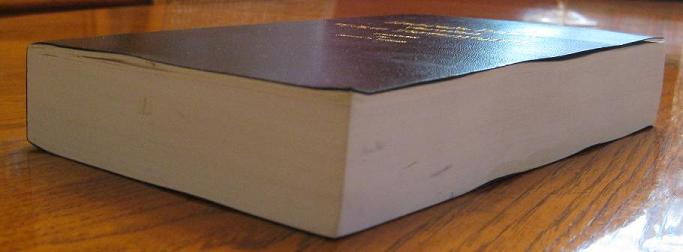
The thickness is comparable to the paperback edition of the Scriptures 98 version.
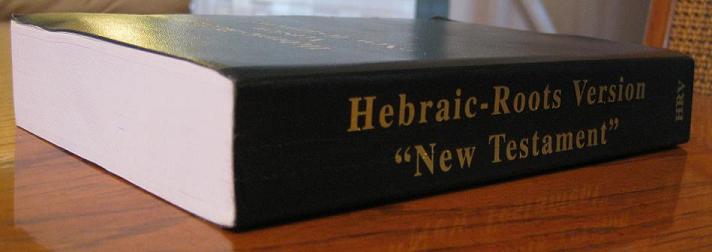
Here you can see the creases in the spine for simply opening the book. Again, the creases are unavoidable if you want to see the text.
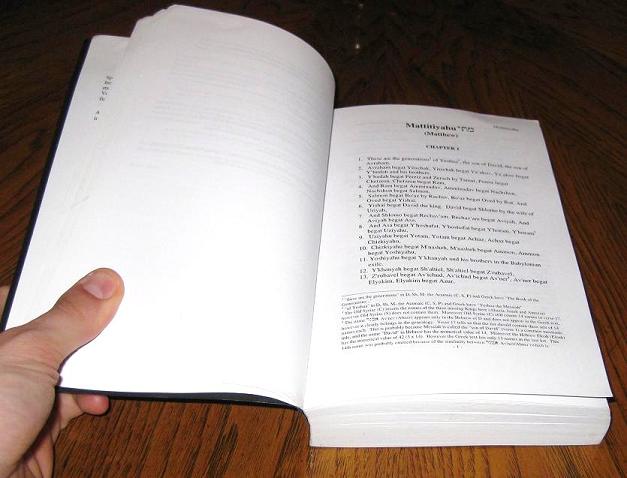
Here is the first chapter of Matthew. You can see the single column verse format and footnotes underneath.
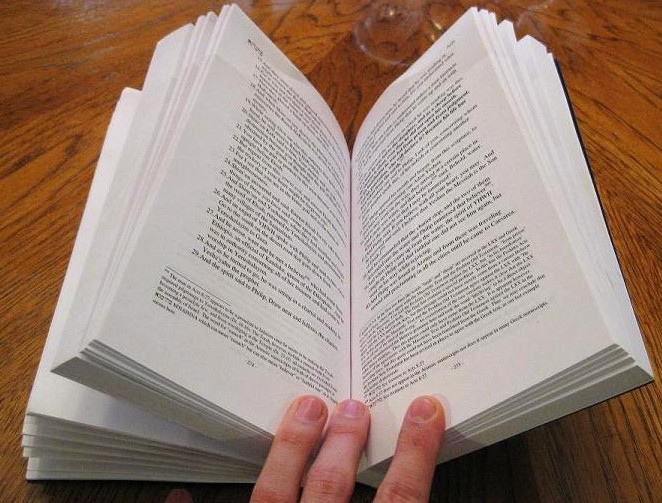
Here you can really see how terrible the binding is. Not only will it never open up flat, it will hardly stay open without your fingers prying it open.
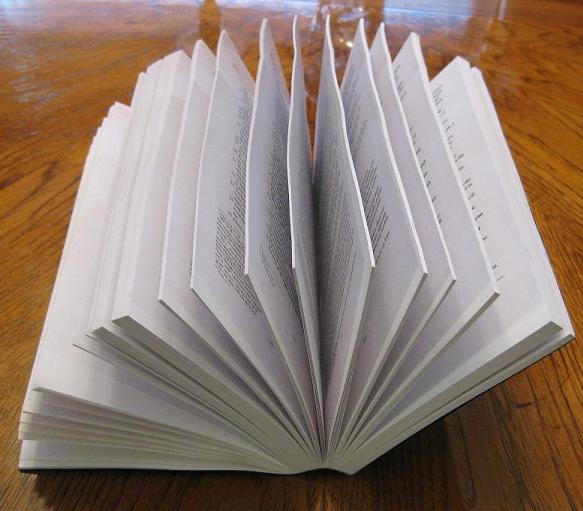
Here is what it looked like after I let go. This is what happens when you use stiff paper and a cheap glued binding as opposed to smyth-sewn.
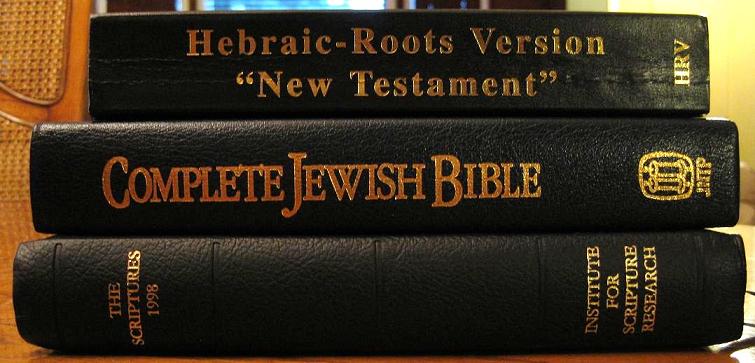
Quite small in size, here it is next to Sterns Complete Jewish Bible and The Scriptures by The Institute for Scripture Research.
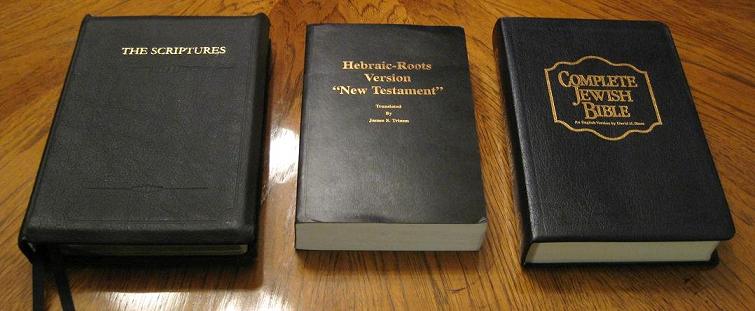
~~~~~~~~~~~~~~
RETURN TO HOME PAGE